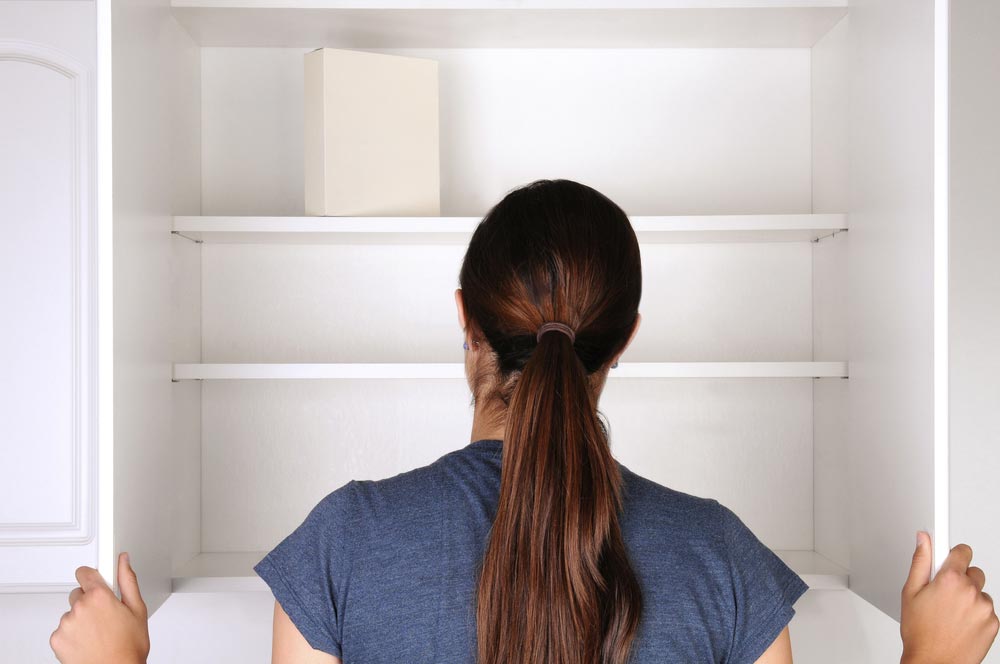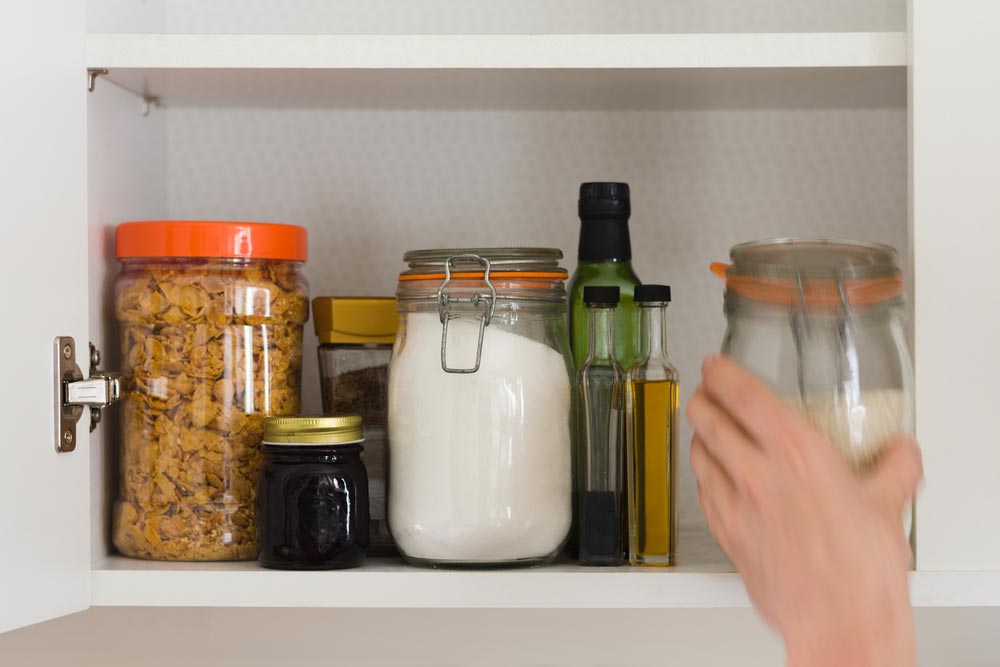Get ready because in today's post pots will roll! That's because you will finally learn how to organize your kitchen cabinet and get rid of that mess once and for all when preparing meals.
Ready to start?
Step by step to organize the kitchen cabinet

Before you start complaining that this is one of the most boring chores out there, we have a tip: put your playlist to play and turn this mission into something more exciting and fun.
After that, just follow the step by step below, starting with the full x-ray of your kitchen.
Understand your kitchen
First of all: understand your kitchen. What does that mean? Simple: you need to understand what type of kitchen you have at home and what main use you make of it.
Is your kitchen small? Planned? Large and spacious? Well lit? Do you cook every day or just occasionally? Do you receive visits frequently?
The answers to these questions will help you organize your kitchen cabinets and your life better, after all, it's not cool to be lost among utensils that you don't even know what they're for.
So, do this analysis before the organization and start to clear your mind to know what to save and where.
Small kitchen vs. large kitchen
Following the idea of the previous topic a little, but this time being a little more specific.
So, if you have a small kitchen, make the most of the vertical space, that is, use niches, shelves and overhead cabinets instead of small furniture on the floor.
It is also important to prioritize the optimization of spaces, occupying the gaps under the counter, for example.
Another useful tip is to use everyday utensils hanging on the wall, such as shells, skimmers and tongs. Pans can also gain air space, as in gourmet kitchens.
The knives can be placed on the sink counter inside supports, as well as the spice jars (if you have space for that).
So you decorate and organize at the same time.
If your kitchen is large, choose the ordered arrangement of objects according to the type of use. For example, pans are closer to the stove, while glasses and plates are closer to the table or counter, making it easier to access and use.
But, even if your kitchen is large, do not overdo the amount of things.
Plan your storage day
Another key tip is to plan the day of organizing the cabinets. Take a day just to do this, you will see that it will be much less stressful.
Also prefer to tidy up your cabinets on a sunny day, so the cabinets dry more easily and you can leave the windows wide open to air all your things.
Empty the cabinets
Every self-respecting organization starts with emptying the cupboards. All of them, including the drawers, okay?
Make space on the table to place all your utensils, crockery and cutlery. If you have a buffet, glass cabinet or other piece of furniture that you use to store dishes, empty them too.
It is important to have all your dishes and kitchen objects in view to ensure impeccable organization.
Do a good cleaning

After you've emptied everything in the cupboards, start cleaning. For this, count on the help of a soft cloth.
A good tip is to make a solution of water with white vinegar or water with baking soda. This mix is perfect for cleaning, disinfecting and eliminating odors from inside the cabinet.
To apply it just wet the cloth and rub the inside of the shelves, drawers and also the doors (don't forget the doors).
If you notice the presence of any dirt that is more difficult to remove, use a sponge (it can be dishwashing detergents) with detergent.
Everything clean and smelling? Now wait for the cabinets to dry completely. But in the meantime, we have another task for you, see below.
Donate, recycle or trash
While your cabinets dry, go to the crockery and utensils on the table and start separating what you use, what you don't even know what it is for and what is broken or no longer useful.
Place the pieces you use in a separate corner. Crockery and utensils that you don't use or that don't serve you anymore donate to someone who may be in need.
Now let's talk about the pots. If you are the type that has pots escaping through the closet door, then stop and reflect on their usefulness. Is it really necessary to make collections of plastic pots?
Can't you just keep the ones you use frequently on a daily basis? Have pots of varying sizes and shapes to meet your daily needs, but nothing more.
The excess of this type of utensil can be stealing precious space in your cabinets and causing the biggest confusion when looking for something.
A tip: to have no doubts whether you really should donate or not, ask yourself how long you haven't used that object. Has it been stopped for at least a year? So you can get rid of it, because the chances of it going through another year without use are very high.
The stained, broken, cracked parts deserve special attention. Some of them, especially glass and ceramic ones, must be discarded, since they cannot be fixed. Already those with spots or small damages, you can choose to stay with them or donate, but before that see if they will really still be used.
Appliances also deserve extra attention. Analyze what you actually use. Nowadays it is very common to find specific devices for each thing, such as cupcake machines, omelettes, popcorn makers and so on.
See what you really need and be honest in your assessment. What just serves to take up space, donate.
For the electrons that need repair, do the maintenance and put them to use again.
The important thing here is to be very clear about what you really need on a daily basis and discard what you do not need.
However, it is worth a caveat. There are certain types of crockery, cutlery, bowls and glasses that are used only on special days, a few times a year. In that case, keep the parts.
Separate by categories
Now that you know what to keep, it's time to organize everything into categories.
Separate glasses, plates, cutlery, cooking accessories, cups and mugs, dessert cups, plastic pots, glass jars, dishes and forms, pans, appliances and whatever else you have in the kitchen.
Then, within each of these categories, make a new separation, only this time assessing what you use daily, what you rarely use.
Ready? Skip to the next tip topic.
Time to keep everything: everything in its place

The time has come to store all your kitchen items. The tip here is to keep utensils in the same category together.
In tall cabinets, which are more difficult to reach, store those parts that are little used or used less frequently, such as sleepers and forms. Make stacks, storing the smallest ones inside the largest ones. Just be careful not to overload the battery, as the weight can crack the pieces.
In the air cabinets that are at eye level, store the glasses and dishes used in everyday life. If you have space you can also store plastic and glass jars there.
Low cabinets or under the sink are great for storing pots and appliances.
If your kitchen has niches and open shelves, consider placing in those spaces only the dishes you use most every day.
The bowls can be displayed on a counter or buffet, but in small quantities. The most chic dishes you use on special days leave to be kept in a separate part of the kitchen cupboard or on the buffet.
Cutlery, accessories such as shells, spatulas, cutting knives and tongs, for example, should go in the drawers, as well as dish towels, table cloths and napkins.
Groceries
Food must be stored in specific and exclusive cabinets. Do not mix them with dishes.
Place foods with the closest expiration date in front so they can be used first. It is also worth separating groceries by type: grains, flours, canned goods, oils, spices, among others.
Count on accessories and supports
Small cabinets or small storage spaces do very well with accessories and supports. Use them to organize cups, store lids, among other objects.
You can easily find these stands in household goods stores.
Baskets and organizing boxes also facilitate the organization of kitchen cabinets.
Spread scents and sachets
Now that everything is clean, kept and organized offer a treat for your kitchen and cabinets.
Do this by spreading sachets with cloves, bay leaves or cinnamon powder inside the drawers and cabinets. In addition to perfuming, herbs and spices help to scare away insects such as ants, flies and cockroaches.
After all this work, enjoy and contemplate your kitchen! And you want to know a good way to do that? Preparing a delicious and special recipe, what do you think?



